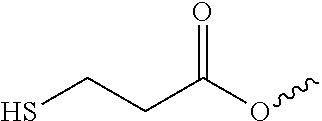Monomers derived from pentacyclopentadecane dimethanol
a pentacyclopentadecane dimethanol and monomer technology, applied in the direction of cellulose adhesives, adhesives, synthetic resin layered products, etc., can solve the problems of inherently poor packing density of polycyclic residues, and achieve the reduction of cure-induced shrinkage, poor packing density of polycyclic residues, and the effect of reducing the stress
- Summary
- Abstract
- Description
- Claims
- Application Information
AI Technical Summary
Benefits of technology
Problems solved by technology
Method used
Image
Examples
example 1
Preparation of Compound C-1
[0098]
[0099]A two-neck, 500 mL flask was charged with 26.24 g (0.1 mole) pentacyclopentadecane dimethanol (Celanese Corp., Dallas, Tex.), 7.93 g (0.11 mole) acrylic acid, 9.47 g (0.11 mole) methacrylic acid, 250 mL toluene, 1.5 g methanesulfonic acid, and 80 mg 4-methoxyphenol. A magnetic stir bar was placed in the flask and a Dean-Stark trap and condenser were attached. The mix was refluxed under an air sparge for three hours and 3.5 mL water (3.6 mL theoretical yield) was collected in the trap. The mixture was cooled to room temperature and neutralized with a mix of 20 g sodium bicarbonate and 4 mL water. The mix was dried with 10 g anhydrous magnesium sulfate and then passed over 25 g of silica gel. The bulk of the toluene was removed under vacuum on a rotary evaporator. The last trace of solvent was removed using an air sparge. The final product was an amber liquid that had a 25° C. viscosity of 5,080 centipoise. The product weighed 35.9 g (93.4% of th...
example 2
Preparation of Compound C-2
[0100]
[0101]A two-neck, one liter flask was charged with 63.0 g (0.24 mole) pentacyclopentadecane dimethanol (PCPD-DM), 56.5 g (0.1 mole) Empol 1008 hydrogenated dimer acid (Cognis Corporation, Cincinnati, Ohio), 400 mL toluene, and 4.0 g methanesulfonic acid. The flask was equipped as in EXAMPLE 1 and the mix was refluxed for 40 minutes to collect 3.8 mL (3.6 mL expected). The flask was cooled and then 11.53 g (0.16 mole) acrylic acid, 13.77 g (0.16 mole) methacrylic acid, and 106 mg 4-methoxyphenol were added and a second reflux was conducted for three hours under an air sparge. Work-up similar to EXAMPLE 1 gave 122.8 g of a clear, red, viscous liquid. The 5 rpm viscosity at 25° C. was 80,267 centipoise. The product had significant absorptions at 2928, 2854, 1726, 1637, 1464, 1406, 1294, 1166, 983, and 810 wavenumbers.
example 3
Preparation of Compound C-3
[0102]
[0103]A two-neck, 500 mL flask was charged with 26.24 g (0.1 mole) pentacyclopentadecane dimethanol, 9.04 g (0.105 mole) methacrylic acid, 29.54 g (0.105 mole) maleimidoundecanoic acid, 150 mL toluene, 2.0 g methanesulfonic acid, and 60 mg hydroquinone. A magnetic stir bar was placed in the flask and a gas inlet tube, Dean-Stark trap and condenser were attached. The mix was refluxed under an air sparge for 3.5 hours and 3.7 mL water (3.6 mL theoretical yield) was collected in the trap. The mixture was cooled to room temperature and neutralized with a mix of 15 g sodium bicarbonate and 5 mL water. The mix was dried with 12 g anhydrous magnesium sulfate and then passed over 20 g of silica gel. The bulk of the toluene was removed under vacuum on a rotary evaporator. The last trace of solvent was removed using an air sparge. The final product was a viscous, clear, red liquid that had a 40° C. viscosity of 3,028 centipoise. The product weighed 55.12 g (92...
PUM
| Property | Measurement | Unit |
|---|---|---|
| temperatures | aaaaa | aaaaa |
| temperatures | aaaaa | aaaaa |
| temperature | aaaaa | aaaaa |
Abstract
Description
Claims
Application Information
 Login to View More
Login to View More - R&D
- Intellectual Property
- Life Sciences
- Materials
- Tech Scout
- Unparalleled Data Quality
- Higher Quality Content
- 60% Fewer Hallucinations
Browse by: Latest US Patents, China's latest patents, Technical Efficacy Thesaurus, Application Domain, Technology Topic, Popular Technical Reports.
© 2025 PatSnap. All rights reserved.Legal|Privacy policy|Modern Slavery Act Transparency Statement|Sitemap|About US| Contact US: help@patsnap.com



